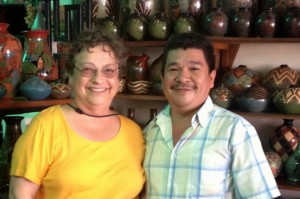In November 2013, five Project Redwood partners traveled to Nicaragua to visit the sites of several funded projects.
I don’t think I’ve ever taken so many pictures on a trip before — Jorge packed our itinerary with intensive exposure to Project Redwood grantees Compatible Techonolgy International (CTI) and Self Help International (SHI), and partner non-profit EOS International projects, staff and communities. He also made sure we saw the beauty of the Nicaraguan countryside every day. We visited an active volcano up close, walked about the main square in 500-hundred-year-old Granada with its lovely cathedral, and drove along through rich agricultural land via well-built highways between major cities (with cattle still controlling the traffic flow at times!). We enjoyed glorious green mountain vistas and beautiful tropical flowers, we watched the sun set on small boats plying Lake Nicaragua, we ate local lake fish in an open-air restaurant, and everywhere we traveled we met charming, friendly people who made us feel at home. When it was time to fly away, I wished that we could stay longer.
Jorge was our only native Spanish speaker; the rest of us ranged from somewhat conversant to somewhat puzzled, but all of us found that smiles and gestures worked wonders at communicating. And, along with Wes Meier of CTI and Nora Tobin of SHI, the Peace Corps volunteers we met in both places did a wonderful job of translating for us when we asked our many questions.
Speaking of Peace Corps volunteers, we also happened to meet a young woman from Japan’s version of the Peace Corps; she is working with the ministry of health (Ministerio de Salud, MINSA) in Matagalpa on disease-prevention programs. Other countries such as Denmark and China have contributed resources and funds for the building of major highways, including Nicaragua’s segment of the Pan-American Highway. And SHI’s administrative director, Lucia Vega Galeano, has received several scholarships funded by Georgetown University to send Central American students to four-year degree programs at various colleges and universities around the United States as well as in Mexico and their own countries. Despite concerns about political and ideological issues, it’s clear that other nations are interested in economic development and stability for the Nicaraguan people.
The challenge for the country is to develop jobs and housing for its marginalized and struggling populations. I think Nicaragua’s people are ready for this. There are MINSA offices in every major town, and water is carried by pipes from mountaintops to villages in many parts of the country. There are village committees to look after community interests, such as purifying the water from those pipes and educating villagers about disease prevention, and there are schools for the children to attend. Coffee plantations and processing plants, along with other enterprises, create jobs. And the people do not seem to be afraid to speak up when problems occur; rather, there is an infectious can-do spirit among the Nicaraguan people, who work hard and are not afraid of responsibility. They want to succeed. To me, Nicaragua is surprisingly organized and ready for modernization.
The cooperative efforts of non-government organizations like CTI, SHI and EOS International are creating ways for the Nicaraguan people to provide better health, better crops and better income for themselves and their families. And that, after all, is what PRW has hoped to do since its inception in 2005. We are truly good partners to the people and communities we serve. Innovation and replicability and sustainability are our strategic goals, but poverty alleviation and living improvements are the essential human purpose of this work.
